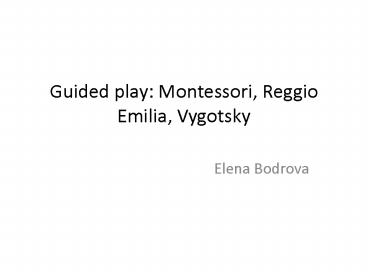Guided play: Montessori, Reggio Emilia, Vygotsky - PowerPoint PPT Presentation
1 / 26
Title:
Guided play: Montessori, Reggio Emilia, Vygotsky
Description:
... stages of play in today's context of American Early Childhood classrooms ... Provide ideas for themes that extend children's experiences and enrich the play ... – PowerPoint PPT presentation
Number of Views:1885
Avg rating:3.0/5.0
Title: Guided play: Montessori, Reggio Emilia, Vygotsky
1
Guided play Montessori, Reggio Emilia, Vygotsky
- Elena Bodrova
2
Challenges of Comparing Different Approaches to
Play
- Defining play
- Defining the approach
- originalism vs. living theory
- what is/was the original focus of the approach
- what are the teaching strategies used in the
classrooms implementing a particular approach
3
Differences Between Approaches
- The definition of play
- The role of objects
- The role of peers
- The role of adults
4
Commonalities Between the Approaches
- Play is viewed as something that
- Comes out of childrens own interests
- Is focused on process and not product
- Involves interaction with others (adults and
peers) - Does not depend on extrinsic rewards
5
The Most Important Commonality
- child-initiated play when
- combined with playful,
- focused learning leads to
- lifelong benefits in ways
- that didactic drills,
- standardized tests, and
- scripted teachings do not.
6
Tools of the Mind
- Comprehensive curriculum (preschool and
kindergarten) - Based on Lev Vygotskys Cultural-Historical
Theory
7
Tools of the Mind effects the development of
executive function and the relationship to child
achievement Diamond et. al. Science, Nov 2007
8
Vygotskian Approach to Play
- The term play is used to describe make-believe
(socio-dramatic) play only - Play is defined by its three major components
- Imaginary situation
- Roles
- Rules
- Play is a leading activity for preschool- and
kindergarten-aged children
9
Lev Vygotsky on Play
- Play also creates the zone of proximal
development of the child. In play, the child is
always behaving beyond his age, above his usual
everyday behavior in play, he is, as it were, a
head above himself. Play contains in a
concentrated form, as in the focus of a
magnifying glass, all developmental tendencies
it is as if the child tries to jump above his
usual level. - (Vygotsky, 1933/1978, p.74)
10
- The kind of play referred to by Vygotsky and
later described by Elkonin as fully developed
or mature play is the only kind of play that
positively affects academic skills as well as
self-regulation
11
Role w/ Peers
Role only
Non-play
Minutes
3 yrs
5 yrs
7 yrs
Age
Manuilenko, 1975/1948
12
In Mature Make-Believe Play
- Children are regulated by others They play a
scenario that is agreed upon by all players (not
necessarily their own idea) - Children regulate other children They tell
other children what to do - Children regulate themselves They stay in the
role and inhibit impulsive behaviors to stay in
the play
13
Replication of the Manuilenkos study
- Todays preschoolers performed at a lower level
than 60 years ago - For many children, taking on a pretend role did
not improve their performance - Elkonin play stages correlated with childrens
ability to follow directions - Gudareva, 2005
14
Purposes of Current Study
(Bodrova et al., 2009)
- Explore the applicability of Elkonins stages of
play in todays context of American Early
Childhood classrooms - Explore the relationship between stages of play
and standardized measures of self-regulation - Explore the relationship between stages of play
and levels of plan written expression
15
Participants
- 42 children
- Attend 3 Head Start classrooms
- All classrooms implement Tools of the Mind
- Average age 4 years 7 months
16
Measures
- Self-regulationHead, Toes, Knees, and Shoulders
(Ponitz, McClelland, Jewkes, Connor, Farris,
Morrison, 2008) - Level of mature playLevels of Play Rubric (Tools
of the Mind) - Level of written language Levels of Drawn and
Written Expression Checklist (Tools of the Mind).
17
Play Planning
- For Vygotsky, make-believe play and drawing are
direct precursors to writing - High level of play was expected to correlate with
high levels of writing
18
Stages of Play (Adapted from Elkonin, 1978)
- Stage 1 First Scripts
- Stage 2 Roles in Action
- Stage 3 Roles with Rules Beginning
- Scenarios
- Stage 4 Mature Roles, Planned Scenarios
Symbolic Props
19
PROPELS Tools of the Mind Play Analysis Rubric
- Plans
- ROles
- Props
- Extended Time Frame
- Language
- Scenario
20
Results Descriptive
21
Results Correlations
22
Discussion
- Preschool children in Head Start program display
various levels of play, but few reach the highest
level of mature play - The findings (distribution of play levels and
the relationship between play levels and
self-regulation) seem to agree with the findings
obtained in post-Vygotskian research
23
Discussion
- Todays social situation almost guarantees that
children may not develop mature play unless
special play scaffolding is provided - Play scaffolding needs to address childrens
current level of play
24
Ways to Scaffold Make-Believe Play
- Make sure children have sufficient time for play
- Choose appropriate props and toys.
- Provide ideas for themes that extend childrens
experiences and enrich the play
25
Ways to Scaffold Make-Believe Play
- Help children plan their play.
- Monitor the progress of play.
- Coach individuals who need help.
26
For more information
- www.toolsofthemind.org































